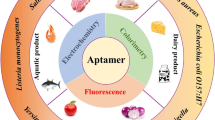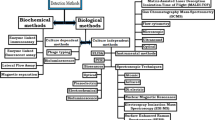Abstract
Cobalt-based zeolitic imidazolate framework nanosheets (ZIF-67) with oxidase-like catalytic activities as an immunoprobe were employed to enhance the sensitivity of an immunoassay. ZIF-67 was synthesized via the solvothermal method using 2-methylimidazole and cobalt dichloride as substrates. A colorimetric immunoassay for Escherichia coli (E. coli) O157:H7 was designed. Preparation of the immunoprobe involved self-polymerized dopamine being applied for the surface modification of ZIF-67 nanosheets in order to bind to the antibody, which was used to identify E. coli O157:H7. ZIF-67 catalyze the oxidation of 3,3′,5,5′-tetramethylbiphenyl (TMB) and produced a color change from colorless to blue. Upon reaction termination, the absorbance was measured at 450 nm. By combining ZIF-67@PDA catalyzed chromogenic reaction with antibody recognition and magnetic separation, the limit of determination is 12 CFU mL−1 and the linear range is 30 to 3.0 × 108 CFU mL−1. The proposed colorimetric immunoassay was successfully utilized to detect E. coli O157:H7 of spiked food samples.

Graphical abstract






Similar content being viewed by others
References
Güner A, Çevik E, Şenel M, Alpsoy L (2017) An electrochemical immunosensor for sensitive detection of Escherichia coli O157:H7 by using chitosan, MWCNT, polypyrrole with gold nanoparticles hybrid sensing platform. Food Chem 229:358–365. https://doi.org/10.1016/j.foodchem.2017.02.083
García-Aljaro C, Muniesa M, Blanco JE, Blanco M, Blanco J, Jofre J, Blanch AR (2005) Characterization of Shiga toxin-producing Escherichia coli isolated from aquatic environments. FEMS Microbiol Lett 246(1):55–65. https://doi.org/10.1016/j.femsle.2005.03.038
Liu Y, Singh P, Mustapha A (2018) High-resolution melt curve PCR assay for specific detection of E. coli O157:H7 in beef. Food Control 86:275–282. https://doi.org/10.1016/j.foodcont.2017.11.025
Wu L, Li G, Xu X, Zhu L, Huang R, Chen X (2019) Application of nano-ELISA in food analysis: recent advances and challenges. TrAC Trends Anal Chem 113:140–156. https://doi.org/10.1016/j.trac.2019.02.002
Sharma H, Mutharasan R (2013) Review of biosensors for foodborne pathogens and toxins. Sensors Actuators B Chem 183(20):535–549. https://doi.org/10.1016/j.snb.2013.03.137
Sun T, Xia N, Yuan F (2020) A colorimetric method for determination of the prostate specific antigen based on enzyme-free cascaded signal amplification via peptide-copper(II) nanoparticles. Microchim Acta 187:116–123. https://doi.org/10.1007/s00604-019-4074-5
Nasir M, Nawaz MH, Latif U (2017) An overview on enzyme-mimicking nanomaterials for use in electrochemical and optical assays. Microchim Acta 184:323–342. https://doi.org/10.1007/s00604-016-2036-8
Lafleur J, Jönsson A, Senkbeil S, Kutter J (2015) Recent advances in lab-on-a-chip for biosensing applications. Biosens Bioelectron 76:213–233. https://doi.org/10.1016/j.bios.2015.08.003
Ma S, Zhou HC, Zhou HC (2010) Gas storage in porous metal-organic frameworks for clean energy applications. Chem Commun 46(1):44–53. https://doi.org/10.1039/b916295j
Si X, Jiao C, Li F, Zhang J, Wang S, Liu S, Li Z, Sun L, Xu F, Gabelica Z, Schick C (2011) High and selective CO2 uptake, H2 storage and methanol sensing on the amine-decorated 12-connected MOF CAU-1. Energy Environ Sci 4(11):4522–4527. https://doi.org/10.1039/C1EE01380G
Yoon M, Suh K, Natarajan S, Kim K (2013) Proton conduction in metal–organic frameworks and related modularly built porous solids. Angew Chem Int Ed 52(10):2688–2700. https://doi.org/10.1002/anie.201206410
Cepeda J, Pérez-Yáñez S, Beobide G, Castillo O, García JÁ, Luque A (2015) Photoluminescence tuning and water detection of yttrium diazinedicarboxylate materials through lanthanide doping. Eur J Inorg Chem 2015(16):2650–2663
Qin J-S, Yuan S, Lollar C, Pang J, Alsalme A, Zhou H-C (2018) Stable metal–organic frameworks as a host platform for catalysis and biomimetics. Chem Commun 54(34):4231–4249. https://doi.org/10.1039/C7CC09173G
Damborský P, Švitel J, Katrlík J (2016) Optical biosensors. Essays Biochem 60(1):91–100. https://doi.org/10.1042/EBC20150010
Anik U, Timur S, Dursun Z (2019) Metal organic frameworks in electrochemical and optical sensing platforms: a review. Microchim Acta 186(3):196–211. https://doi.org/10.1007/s00604-019-3321-0
Xu S (2012) Electromechanical biosensors for pathogen detection. Microchim Acta 178(3–4):245–260. https://doi.org/10.1007/s00604-012-0831-4
Xu M, Wang R, Li Y (2017) Electrochemical biosensors for rapid detection of Escherichia coli O157:H7. Talanta 162:511–522. https://doi.org/10.1016/j.talanta.2016.10.050
Xue L, Zheng L, Zhang H, Jin X, Lin J (2018) An ultrasensitive fluorescent biosensor using high gradient magnetic separation and quantum dots for fast detection of foodborne pathogenic bacteria. Sensors Actuators B Chem 265:318–325. https://doi.org/10.1016/j.snb.2018.03.014
Zhou L, Shen Q, Zhao P, Xiang B, Nie Z, Huang Y, Yao S (2013) Fluorescent detection of copper(II) based on DNA-templated click chemistry and graphene oxide. Methods 64(3):299–304. https://doi.org/10.1016/j.ymeth.2013.09.001
Ortiz-Gómez I, Salinas-Castillo A, García AG, Álvarez-Bermejo JA, de Orbe-Payá I, Rodríguez-Diéguez A, Capitán-Vallvey LF (2017) Microfluidic paper-based device for colorimetric determination of glucose based on a metal-organic framework acting as peroxidase mimetic. Microchim Acta 185(1):47. https://doi.org/10.1007/s00604-017-2575-7
Yang H, Yang R, Zhang P, Qin Y, Chen T, Ye F (2017) A bimetallic (Co/2Fe) metal-organic framework with oxidase and peroxidase mimicking activity for colorimetric detection of hydrogen peroxide. Microchim Acta 184(12):4629–4635. https://doi.org/10.1007/s00604-017-2509-4
Wang S, Deng W, Yang L, Tan Y, Xie Q, Yao S (2017) Copper-based metal–organic framework nanoparticles with peroxidase-like activity for sensitive colorimetric detection of Staphylococcus aureus. ACS Appl Mater Interfaces 9(29):24440–24445. https://doi.org/10.1021/acsami.7b07307
Bhardwaj N, Bhardwaj SK, Mehta J, Kim KH, Deep A (2017) MOF-bacteriophage biosensor for highly sensitive and specific detection of S. aureus. ACS Appl Mater Interfaces 9(39):33589–33598. https://doi.org/10.1021/acsami.7b07818
Pan Y, Li H, Zhang X-X, Zhang Z, Tong X-S, Jia C-Z, Liu B, Sun C-Y, Yang L-Y, Chen G-J (2015) Large-scale synthesis of ZIF-67 and highly efficient carbon capture using a ZIF-67/glycol-2-methylimidazole slurry. Chem Eng Sci 137:504–514. https://doi.org/10.1016/j.ces.2015.06.069
Si J, Yang H (2011) Preparation and characterization of bio-compatible Fe3O4@Polydopamine spheres with core/shell nanostructure. Mater Chem Phys 128(3):519–524. https://doi.org/10.1016/j.matchemphys.2011.03.039
Jiao L, Wang Y, Jiang H-L, Xu Q (2018) Metal–organic frameworks as platforms for catalytic applications. Adv Mater 30(37):1703663. https://doi.org/10.1002/adma.201703663
Z-h Z, J-l Z, J-m L, Z-h X, Chen X (2016) Selective and competitive adsorption of azo dyes on the metal–organic framework ZIF-67. Water Air Soil Pollut 227(12):471. https://doi.org/10.1007/s11270-016-3166-7
Zhou K, Mousavi B, Luo Z, Phatanasri S, Chaemchuen S, Verpoort F (2017) Characterization and properties of Zn/Co zeolitic imidazolate frameworks vs. ZIF-8 and ZIF-67. J Mater Chem A 5(3):952–957. https://doi.org/10.1039/C6TA07860E
Tang J, Shi Z, Berry RM, Tam KC (2015) Mussel-inspired green metallization of silver nanoparticles on cellulose nanocrystals and their enhanced catalytic reduction of 4-nitrophenol in the presence of β-cyclodextrin. Ind Eng Chem Res 54(13):3299–3308
Xiong C, Zhang T, Kong W, Zhang Z, Qu H, Chen W, Wang Y, Luo L, Zheng L (2018) ZIF-67 derived porous Co3O4 hollow nanopolyhedron functionalized solution-gated graphene transistors for simultaneous detection of glucose and uric acid in tears. Biosens Bioelectron 101:21–28. https://doi.org/10.1016/j.bios.2017.10.004
Zeng T, Zhang X, Niu H, Ma Y, Li W, Cai Y (2013) In situ growth of gold nanoparticles onto polydopamine-encapsulated magnetic microspheres for catalytic reduction of nitrobenzene. Appl Catal B Environ 134-135:26–33. https://doi.org/10.1016/j.apcatb.2012.12.037
Wang S, Xu D, Ma L, Qiu J, Wang X, Dong Q, Zhang Q, Pan J, Liu Q (2018) Ultrathin ZIF-67 nanosheets as a colorimetric biosensing platform for peroxidase-like catalysis. Anal Bioanal Chem 410(13):7145–7152. https://doi.org/10.1007/s00216-018-1317-y
Wang X, Cao W, Qin L, Lin T, Chen W, Lin S, Yao J, Zhao X, Zhou M, Hang C, Wei H (2017) Boosting the peroxidase-like activity of nanostructured nickel by inducing its 3+ oxidation state in LaNiO(3) perovskite and its application for biomedical assays. Theranostics 7(8):2277–2286. https://doi.org/10.7150/thno.19257
Wang X, Gao XJ, Qin L, Wang C, Song L, Zhou Y-N, Zhu G, Cao W, Lin S, Zhou L, Wang K, Zhang H, Jin Z, Wang P, Gao X, Wei H (2019) e(g) occupancy as an effective descriptor for the catalytic activity of perovskite oxide-based peroxidase mimics. Nat Commun 10(1):704–712. https://doi.org/10.1038/s41467-019-08657-5
Lunhong A, Lili L, Caihong Z, Jian F, Jing J (2013) MIL-53(Fe): a metal-organic framework with intrinsic peroxidase-like catalytic activity for colorimetric biosensing. Chemistry 19(45):15105–15108
Song C, Liu J, Li J, Liu Q (2016) Dual FITC lateral flow immunoassay for sensitive detection of Escherichia coli O157:H7 in food samples. Biosens Bioelectron 85:734–739. https://doi.org/10.1016/j.bios.2016.05.057
Funding
We acknowledge the financial support of the National Key R&D Program of China (2018YFC1602500), the Science and Technology Innovation Plan of Shanghai (No. 18495800400), the National Natural Science Foundation of China (No. 81572809, 31871897), and the National Natural Science Foundation for Young Scientists of China (No. 81502504, 31801455).
Author information
Authors and Affiliations
Corresponding authors
Ethics declarations
Conflict of interest
The author(s) declare that they have no competing interests.
Additional information
Publisher’s note
Springer Nature remains neutral with regard to jurisdictional claims in published maps and institutional affiliations.
Electronic supplementary material
ESM 1
(DOCX 2188 kb).
Rights and permissions
About this article
Cite this article
Wang, S., Xu, D., Ding, C. et al. A colorimetric immunoassay for determination of Escherichia coli O157:H7 based on oxidase-like activity of cobalt-based zeolitic imidazolate framework. Microchim Acta 187, 506 (2020). https://doi.org/10.1007/s00604-020-04407-3
Received:
Accepted:
Published:
DOI: https://doi.org/10.1007/s00604-020-04407-3




